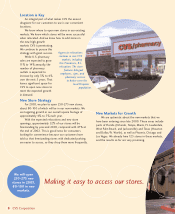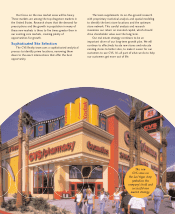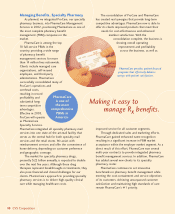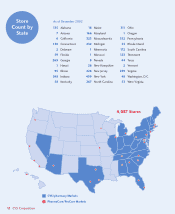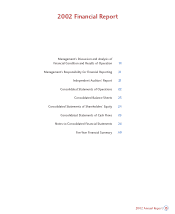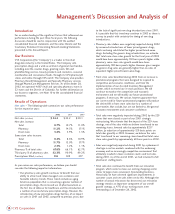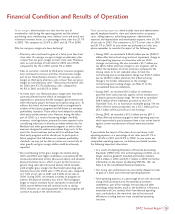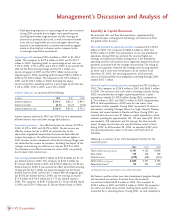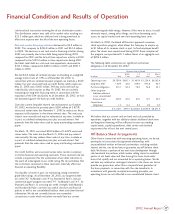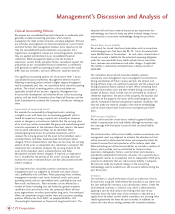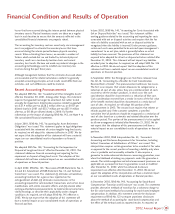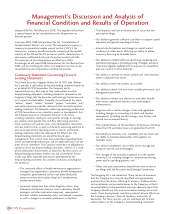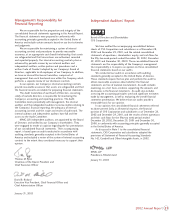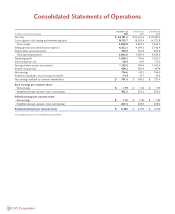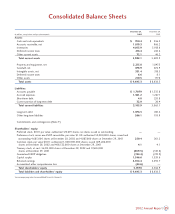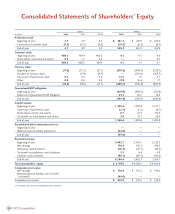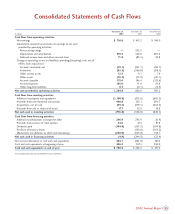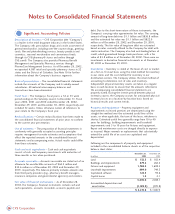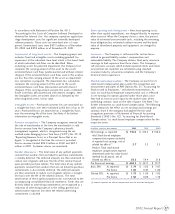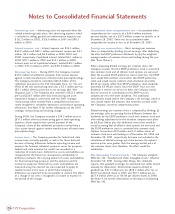CVS 2002 Annual Report Download - page 20
Download and view the complete annual report
Please find page 20 of the 2002 CVS annual report below. You can navigate through the pages in the report by either clicking on the pages listed below, or by using the keyword search tool below to find specific information within the annual report.
Critical Accounting Policies
We prepare our consolidated financial statements in conformity with
generally accepted accounting principles, which requires
management to make certain estimates and apply judgment. We base
our estimates and judgments on historical experience, current trends
and other factors that management believes to be important at the
time the consolidated financial statements are prepared. On a
regular basis, management reviews our accounting policies and how
they are applied and disclosed in our consolidated financial
statements. While management believes that the historical
experience, current trends and other factors considered support the
preparation of our consolidated financial statements in conformity
with generally accepted accounting principles, actual results could
differ from our estimates, and such differences could be material.
Our significant accounting policies are discussed in Note 1 to our
consolidated financial statements. Management believes that the
following accounting policies include a higher degree of judgment
and/or complexity and, thus, are considered to be critical accounting
policies. The critical accounting policies discussed below are
applicable to both of our business segments. Management has
discussed the development and selection of our critical accounting
policies with the Audit Committee of our Board of Directors and the
Audit Committee has reviewed the Company’s disclosures relating to
them.
Impairment of Long-Lived Assets
We evaluate the recoverability of long-lived assets, including
intangible assets with finite lives, but excluding goodwill, which is
tested for impairment using a separate test, annually or whenever
events or changes in circumstances indicate that the carrying value
of an asset may not be recoverable. We group and evaluate long-lived
assets for impairment at the individual store level, which is the lowest
level at which individual cash flows can be identified. When
evaluating long-lived assets for potential impairment, we first
compare the carrying amount of the asset to the individual store’s
estimated future cash flows (undiscounted and without interest
charges). If the estimated future cash flows are less than the carrying
amount of the asset, an impairment loss calculation is prepared. The
impairment loss calculation compares the carrying amount of the
asset to the individual store’s estimated future cash flows
(discounted and with interest charges). If required, an impairment
loss is recorded for the portion of the asset’s carrying value that
exceeds the asset’s estimated future cash flow (discounted and with
interest charges).
Our impairment loss calculation contains uncertainty since
management must use judgment to estimate each store’s future
sales, profitability and cash flows. When preparing these estimates,
management considers each store’s historical results and current
operating trends and our consolidated sales, profitability and cash
flow results and forecasts. These estimates can be affected by a
number of factors including, but not limited to, general economic
conditions, the cost of real estate, the continued efforts of third
party organizations to reduce prescription drug costs, the continued
efforts of competitors to gain market share and consumer spending
patterns. Effective for fiscal 2002, we adopted SFAS No. 144
“Accounting for Impairment or Disposal of Long-Lived Assets.” The
adoption did not have a material impact on our impairment loss
methodology, nor have we made any other material changes to our
impairment loss assessment methodology during the past three
years.
Closed Store Lease Liability
We account for closed store lease termination costs in accordance
with Emerging Issues Task Force No 88-10, “Costs Associated with
Lease Modifications or Termination.” As such, when a leased store is
closed, we record a liability for the estimated remaining obligation
under the non-cancelable lease, which includes future real estate
taxes, common area maintenance and other charges, if applicable.
The liability is reduced by estimated future sublease income if
applicable.
The calculation of our closed store lease liability contains
uncertainty since management must use judgment to estimate the
timing and duration of future vacancy periods, the amount and
timing of future lump sum settlement payments and the amount and
timing of potential future sublease income. When estimating these
potential termination costs and their related timing, we consider a
number of factors, which include, but are not limited to, historical
settlement experience, the owner of the property, the location and
condition of the property, the terms of the underlying lease, the
specific marketplace demand and general economic conditions. We
have not made any material changes in the reserve methodology
used to record closed store lease reserves during the past three
years.
Self-Insurance Liabilities
We are self insured for certain losses related to general liability,
worker’s compensation and auto liability although we maintain stop
loss coverage with third party insurers to limit our total liability
exposure.
The estimate of our self-insurance liability contains uncertainty since
management must use judgment to estimate the ultimate cost that
will be incurred to settle reported claims and unreported claims for
incidents incurred but not reported as of the balance sheet date.
When estimating our self-insurance liability, we consider a number of
factors, which include, but are not limited to, historical claim
experience, demographic factors, severity factors and valuations
provided by independent third-party actuaries. On a quarterly basis,
management reviews its assumptions with its independent third party
actuaries to determine that our self-insurance liability is adequate.
We have not made any material changes in the accounting
methodology used to establish our self-insurance liability during the
past three years.
Inventory
Our inventory is valued at the lower of cost or market on a first-in,
first-out basis using the retail method for inventory in our stores and
the cost method for inventory in our distribution centers. Under the
retail method, inventory is stated at cost, which is determined by
applying a cost-to-retail ratio to the ending retail value of our
inventory. Since the retail value of our inventory is adjusted on a
regular basis to reflect current market conditions, our carrying value
should approximate the lower of cost or market. In addition, we
reduce the value of our ending inventory for estimated inventory
Management’s Discussion and Analysis of
18 CVS Corporation


